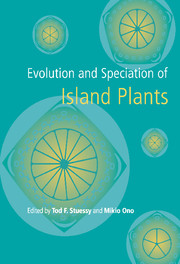Book contents
- Frontmatter
- Contents
- List of contributors
- Preface
- Acknowledgements
- Part one Hawaiian Islands
- Part two Juan Fernandez Islands
- Introduction
- 3 Isolating mechanisms and modes of speciation in endemic angiosperms of the Juan Fernandez Islands
- 4 Dendroseris (Asteraceae: Lactuceae) and Robinsonia (Asteraceae: Senecioneae) on the Juan Fernandez Islands: similarities and differences in biology and phylogeny
- 5 Island biogeography of angiosperms of the Juan Fernandez archipelago
- Part three Southern and western Pacific Islands
- Part four General evolutionary patterns and processes on oceanic islands
- Author index
- Taxon index
- Subject index
4 - Dendroseris (Asteraceae: Lactuceae) and Robinsonia (Asteraceae: Senecioneae) on the Juan Fernandez Islands: similarities and differences in biology and phylogeny
Published online by Cambridge University Press: 04 May 2010
- Frontmatter
- Contents
- List of contributors
- Preface
- Acknowledgements
- Part one Hawaiian Islands
- Part two Juan Fernandez Islands
- Introduction
- 3 Isolating mechanisms and modes of speciation in endemic angiosperms of the Juan Fernandez Islands
- 4 Dendroseris (Asteraceae: Lactuceae) and Robinsonia (Asteraceae: Senecioneae) on the Juan Fernandez Islands: similarities and differences in biology and phylogeny
- 5 Island biogeography of angiosperms of the Juan Fernandez archipelago
- Part three Southern and western Pacific Islands
- Part four General evolutionary patterns and processes on oceanic islands
- Author index
- Taxon index
- Subject index
Summary
Abstract
The biology and phylogeny of Dendroseris and Robinsonia (Asteraceae), two genera endemic to the Juan Fernandez Islands, are discussed and contrasted. Morphological and molecular data were used to test the monophyly and to generate phylogenetic hypotheses for the two genera. Restriction site mutations in the chloroplast DNA (cpDNA) and intergenic spacer (IGS) region of the nuclear ribosomal DNA (rDNA) were used to produce a phylogeny of each genus, and sequences from the internal transcribed spacer (ITS) region of the nuclear rDNA were also employed to generate phylogenies. All molecular data sets strongly support the monophyly of each genus despite the morphological and ecological diversity found in them. For Dendroseris, all molecular information, in concordance with morphology, shows that the two subgenera Dendroseris and Phoenicoseris are monophyletic, but this is not true for subg. Rea. The restriction site data for Robinsonia do not provide any phylogenetic resolution whereas the ITS sequences produce a completely resolved tree that is concordant with relationships inferred from morphology. Allozyme diversity is higher in species of Robinsonia than in those of Dendroseris and divergence between species is likewise higher in Robinsonia. Differences in diversity may reflect factors such as amount of genetic variation carried to the island by the original colonizers, population sizes and breeding systems. Higher allozyme divergence between species of Robinsonia could result from sorting of alleles from polymorphic ancestors during speciation. Also, Robinsonia may have been on the Juan Fernandez Islands longer than Dendroseris, thereby allowing time for the accumulation of unique alleles via mutation subsequent to speciation.
- Type
- Chapter
- Information
- Evolution and Speciation of Island Plants , pp. 97 - 120Publisher: Cambridge University PressPrint publication year: 1998
- 18
- Cited by



